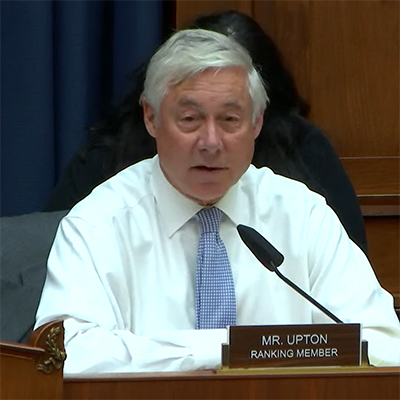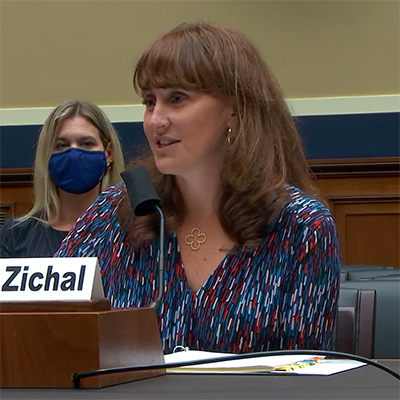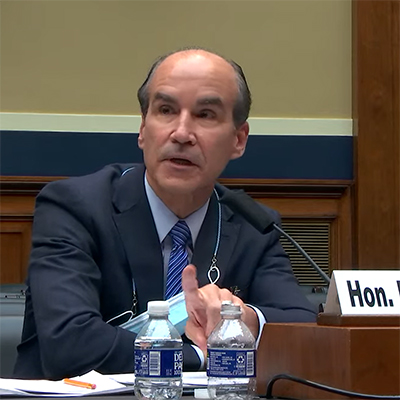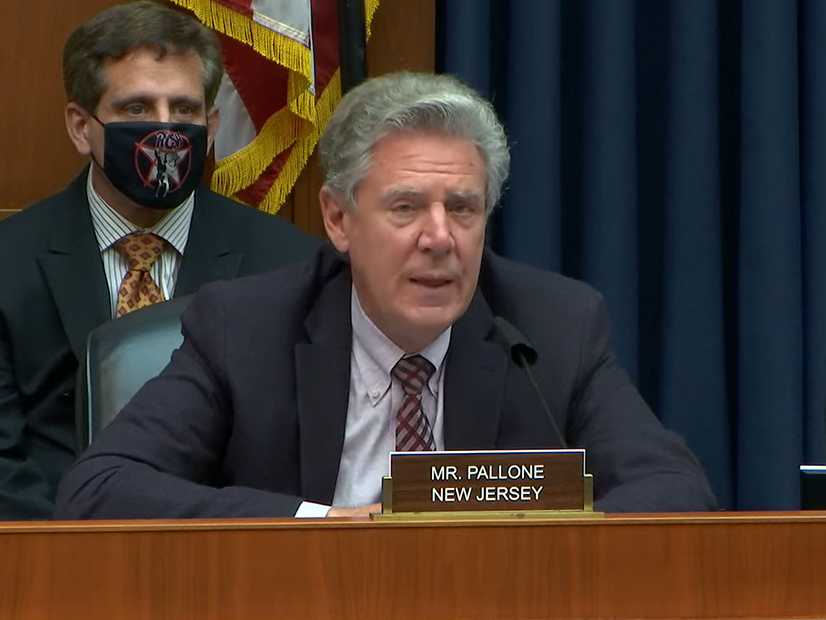Throughout a four-hour session Thursday, the House Energy and Commerce Subcommittee on Energy’s Democratic members kept the focus on the economic development potential of the offshore wind industry and its emerging domestic supply chain and jobs. Republicans meanwhile hammered away on current high oil and gas prices and possible threats to the affordability and reliability of the nation’s energy supply as winter approaches.
Energy and Commerce Committee Chair Frank Pallone (D-N.J.) cited the positive impacts of the emerging offshore industry in his home state, which is working toward deploying 7,500 MW of projects by 2035. Three projects now moving forward have brought “thousands of jobs and billions of dollars of investment to the Garden State. But to be clear, the economic benefits of offshore wind won’t just accrue on the coast; they will impact communities across the country,” Pallone said.
 Rep. Fred Upton (R-Mich.) | House Energy and Commerce Committee
Rep. Fred Upton (R-Mich.) | House Energy and Commerce CommitteeHe pointed to a recent report from the Business Network for Offshore Wind that found more than 500 supply contracts for offshore components across the country and pitched for the transmission funding in the Democrats’ budget reconciliation bill. Pallone also argued that fossil fuels and their volatile price swings are creating uncertainty and unreliability for energy consumers. “Doubling down on existing fossil fuel infrastructure makes little sense.”
Rep. Fred Upton (R-Mich.), the subcommittee’s ranking member, said he was “a little bit troubled by the topic of today’s hearing because we are in an energy crisis right now, which is what I believe this committee ought to be focused on. The price of gas and many energy commodities are at a seven-year high,” with the Energy Information Administration anticipating price rises in propane (54%), heating oil (43%) and electric heating (6%) in the months ahead.
He also questioned the feasibility of President Biden’s goal of deploying 30 GW of wind off both coasts by 2030. “It’s very difficult to imagine that any projects are going to get built without substantial taxpayer and ratepayer subsidies, and of course, we have the questions of permitting,” Upton said. Other obstacles include “poor economics, operating reliability in harsh conditions … negative environmental and fishery impacts, workforce and labor issues,” he said.
 Rep. Kim Schrier (D-Wash.) | House Energy and Commerce Committee
Rep. Kim Schrier (D-Wash.) | House Energy and Commerce CommitteeThese basic positions were replayed, with minor variations, throughout the hearing, reflecting the tension between current concerns over rising energy costs and the planning and investment required to shift the nation’s energy supply to clean sources.
Rep. Kim Schrier (D-Wash.) saw the apparent conflict as more of a false dichotomy given the mounting impacts of climate change.
“We need a full portfolio of alternative sources of energy: hydro, nuclear, solar and wind, including offshore and onshore,” Schrier said. “But no natural gas is coming offline until we have enough renewable energy to replace it; so, tying these together, which some of my colleagues are doing, is misleading. It’s fear mongering, and it’s just making a bunch of excuses for doing nothing.”
Building a US Supply Chain
The current momentum behind offshore wind at the federal and state level comes as the U.S. finds itself lagging in a booming global market. According to the Department of Energy’s 2021 Offshore Wind Market Report, while the U.S. offshore project pipeline stands at 35 GW, actual projects in operation total only 42 MW versus the 33 GW of installed capacity worldwide. Europe and China are the market leaders.
 Heather Zichal, ACP | House Energy and Commerce Committee
Heather Zichal, ACP | House Energy and Commerce CommitteeStill, Heather Zichal, CEO of the American Clean Power Association (ACP), provided an optimistic overview of the emerging U.S. industry, with Biden’s 30-GW goal and other state targets jump-starting a domestic supply chain that will provide certainty for developers and investors.
Looking ahead, Zichal called for a federal tax credit for offshore wind component manufacturing and federal leadership in planning the transmission and distribution systems that will be needed to meet Biden’s target. While some projects will be able to interconnect through existing infrastructure, Zichal said, “sustaining long-term growth of offshore wind will require a coordinated approach to transmission that spans multiple-leased areas, states and regions. Forward-thinking transmission planning will help to expand the market for offshore wind more quickly and benefit the supply chain,” she said.
FERC’s Advance Notice of Proposed Rulemaking on transmission planning and cost allocation is a good first step, she said, as is PJM’s work with New Jersey, integrating the state’s project pipeline into its regional planning. (See FERC Tx Inquiry: Consensus on Need for Change, Discord over Solutions.)
 David Hardy, Orsted North America | House Energy and Commerce Committee
David Hardy, Orsted North America | House Energy and Commerce CommitteeDavid Hardy, CEO of Ørsted North America, began his presentation by noting his firm’s Danish parent company started out in fossil fuels but is now fully divested from oil and gas, focusing instead on renewables. In the U.S., the company is taking a two-pronged approach to building the domestic supply chain it needs for projects to be built off the coasts of New Jersey, New York, Connecticut and Rhode Island.
“This includes first building U.S. capability with existing American companies and, second, attracting European firms to build facilities here in the U.S., creating foreign direct investment in new American jobs,” Hardy said.
Ørsted has partnered with Kiewit, a Nebraska-based engineering and construction firm, to build an American-made offshore wind substation, which will be manufactured in Texas, he said. Factories in Pennsylvania, North Carolina, Alabama and West Virginia will be producing steel for American-made offshore wind installation and operations vessels, also being built in Texas.
But Hardy cautioned against comparing the nascent offshore industry in the U.S. with its more developed counterpart in Europe, which “has had several decades to build the infrastructure needed to support a mature offshore wind industry. Although we are making considerable progress in building the U.S. supply chain, it remains a challenge that needs regulatory certainty and incentives if we want to achieve 30 GW by 2030,” he said.
 Mark Menezes | House Energy and Commerce Committee
Mark Menezes | House Energy and Commerce CommitteeSpeaking as a private citizen, Mark Menezes, former deputy energy secretary under President Donald Trump, was less bullish on offshore wind, acknowledging its potential but arguing the technology still faces too many obstacles and high costs. He pointed to Maine, where Gov. Janet Mills recently signed a new law banning offshore wind projects in state waters — aimed at protecting the state’s lobster and recreation industries — while allowing development in federal waters.
Menezes and other Republicans also pointed to the current spike in energy prices in Europe, which they linked to the region’s reliance on offshore wind and a lull in North Sea wind speeds in September.
According to WindEurope, an industry trade group, combined on- and offshore wind energy provided 23.4% of the region’s power on Friday. The European Commission is pushing even faster deployment of renewables as the solution to high electricity and gas prices, along with targeted, near-term measures to protect the region’s most vulnerable populations from the current high prices.
Winter Wind, More Power
Responding to a question from Rep. Cathy McMorris Rodgers (R-Wash.), the full committee’s ranking member, Menezes criticized Biden’s cancellation of the Keystone XL pipeline and his initial moratorium on oil and gas leasing on federal land. Such actions, he said, may have had a chilling effect on oil and gas investment.
Following a court order, the moratorium was lifted, and a recent Associated Press report found that the Interior Department has approved 2,100 permits for oil and gas drilling on federal land since Biden took office in January, the highest level since George W. Bush was president.
Meanwhile, a question from Rep. Diana DeGette (D-Colo.) gave Hardy the opportunity to counter Republican concerns about the performance of offshore turbines in harsh weather. In high winds, the turbines will shut down to “protect themselves,” he said.


